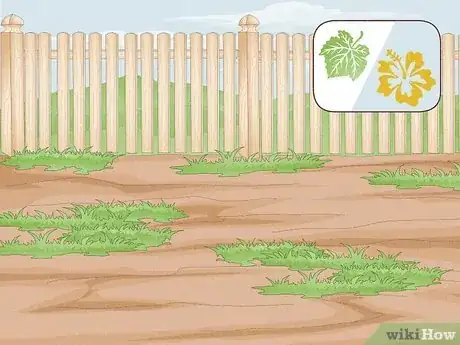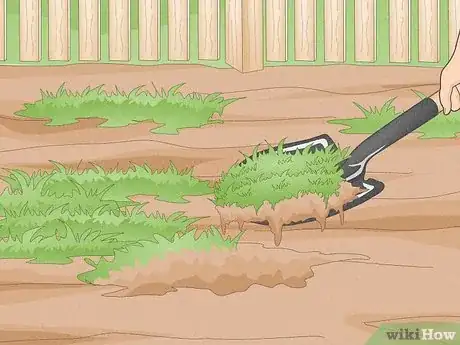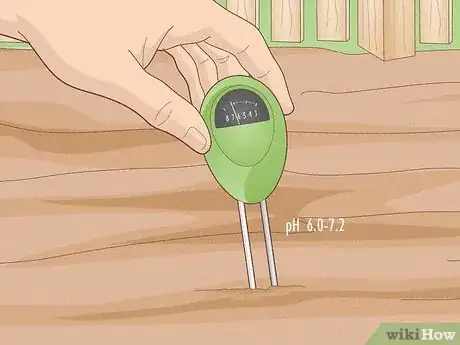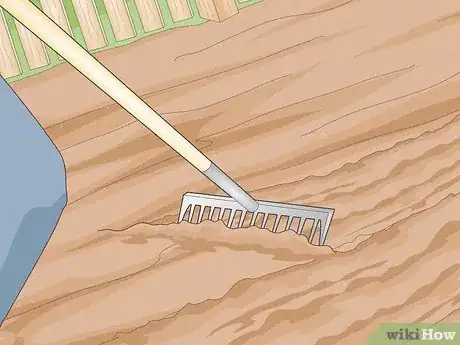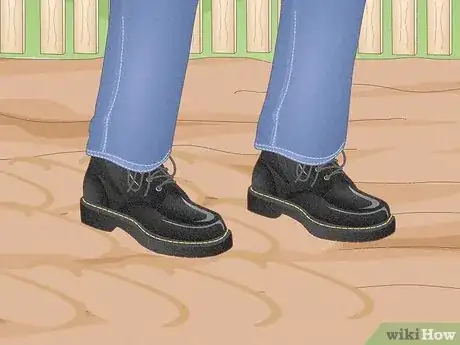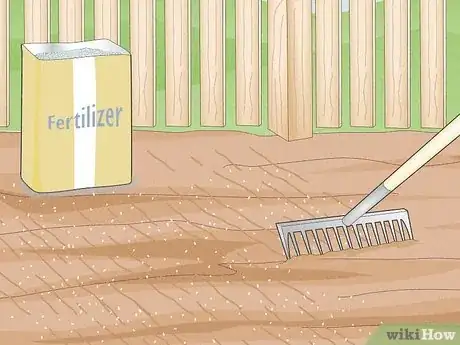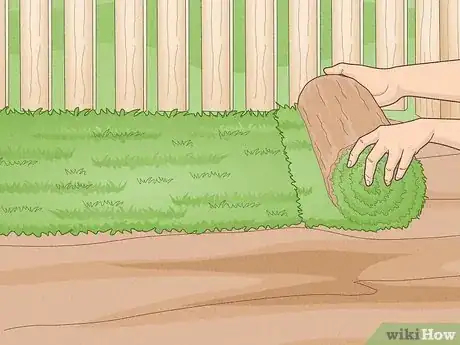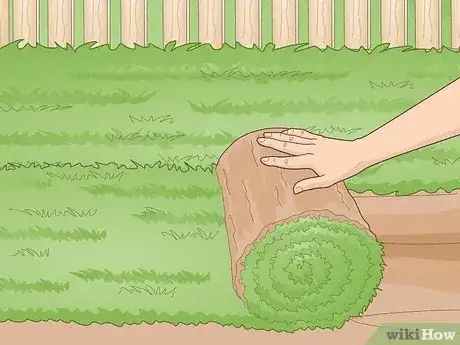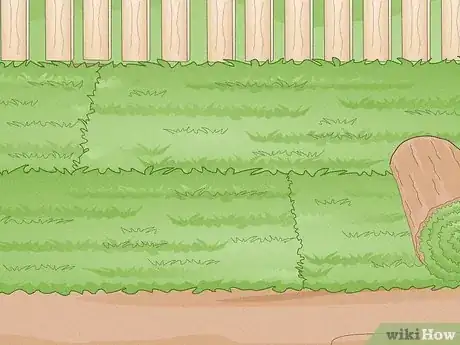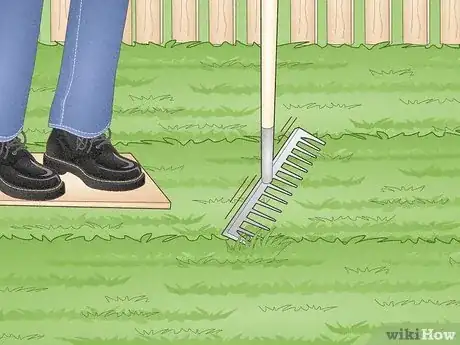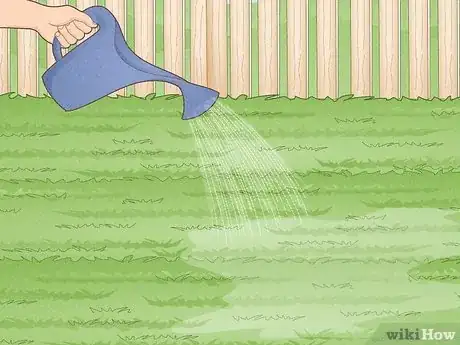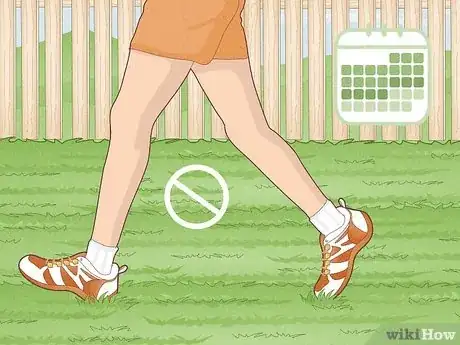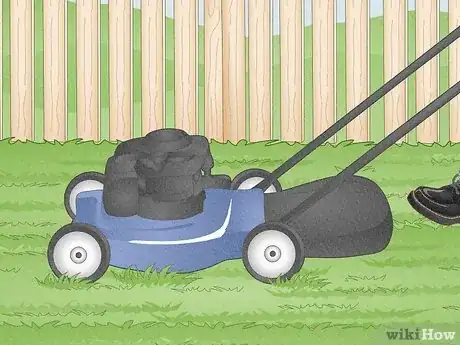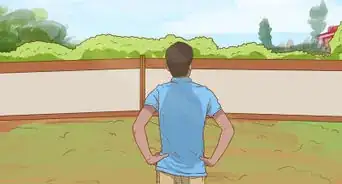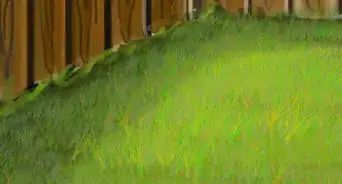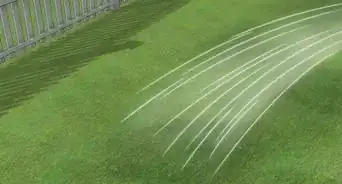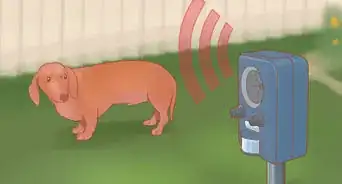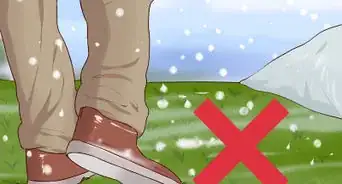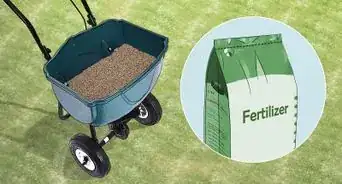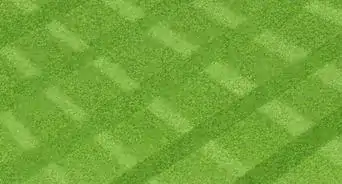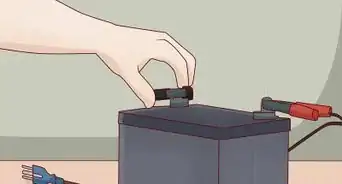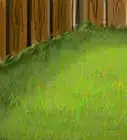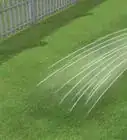This article was co-authored by Benjamin Hansen and by wikiHow staff writer, Kyle Hall. Benjamin Hansen is a Landscape Contractor and the Owner of Artscape Gardens, a boutique landscaping company in Los Angeles, California. With over 12 years of experience, Benjamin specializes in transforming properties into aesthetic, functional, and drought-tolerant oases. Benjamin uses color scheme, dimension, and water conscious spaces to inspire the design and installation of soft scape, hardscape, patios, pathways, irrigation, drainage, fencing, concrete, lighting, and electrical work. Artscape Gardens covers all areas of the C-27 landscape contractor classification.
There are 16 references cited in this article, which can be found at the bottom of the page.
This article has been viewed 147,245 times.
If you’ve ever envied your neighbor's lush green lawn, you might be thinking about laying down some turf in your yard. Turf is an easy way to replace a patchy lawn with bright, even grass, but only if you do it the right way. By cleaning up your old lawn, adding some fertilizer, and rolling out the new turf properly, you can have a brand-new looking lawn in no time.
Steps
Getting the Lawn Ready
-
1Wait to lay down new turf until fall or spring if possible. Fall and spring are the best seasons for turf to root into the ground because of all the rain. Winter can be too cold and summer can be too dry for turf to root.[1]
- If you wish to put down turf in the summer, or your area does not get enough rainfall in fall and spring, install a watering system or use a hose and sprinkler to make sure your turf gets enough water.
- If you are installing turf in the fall, lay it down early enough so that it is well established and rooted at least 6 weeks before the first hard freeze of winter.
- Artificial turf is more expensive than real sod up front, but it doesn't need real maintenance afterwards, and often has a warranty of about 16 years.[2]
-
2Remove any existing grass or turf from the lawn. Pull up any weeds or stones you come across. Use a spade or shovel to make clearing out the old lawn easier.[3]
- If the lawn has a lot of weeds, spray it with a weed killer and wait about 48 hours for the weeds to die so they’re easier to remove.[4]
Advertisement -
3Test your soil pH, and adjust if necessary. Buy a soil testing kit from your garden center or nursery and test a few samples from different parts of your yard. Test your soil a few months in advance of when you plan to lay down the turf, because it may take some time for any necessary amendments to take effect.
- Most turfgrass species prefer a soil pH between 6.0 and 7.2.[5]
- If your soil is too acidic (low pH), add some ground limestone to the soil. Garden lime can be bought in most garden supply stores.
- If your soil is too alkaline (high pH), add garden sulfur or some type of acidic mulch, such as pine needles.[6]
- Some soil testing kits also allow you to check your soil’s nutrient levels.
-
4Level the lawn if it’s uneven using topsoil. Pour the topsoil over the lawn and distribute it evenly using a rake. Make sure you fill in holes and break up any mounds of dirt on the lawn. [7]
- Topsoil is a surface soil that is high in nutrients. You can find bags of topsoil at your local garden center.[8]
-
5Pack down the top layer of soil using your feet. Walk across the lawn slowly and apply pressure with your feet, making sure every inch of the surface is packed. Rake across the surface of the soil again.[9]
- To pack soil down more efficiently, rent or buy a water-weighted lawn roller from a garden center or home improvement store. Many models can be either pushed by hand or towed behind a tractor.
- Adding turf will raise the level of your lawn by about 2 inches (5 cm), so pack your existing soil or turf down by at least that much.
-
6Rake a granular fertilizer over the surface of the soil. A granular fertilizer is just a non-liquid fertilizer.[10] You can find one at your local garden center. Sprinkle the granules of fertilizer across the lawn using your hands or a small hand-held spreader, making sure you don’t miss any spots.[11]
Putting down the Turf
-
1Unroll the first patch of turf, starting at the farthest edge of the lawn. Unroll the turf so the longest side of the turf is parallel with the longest edge of the lawn. Gently press the turf into the ground using your hands.[14]
-
2Unroll the second patch of turf so it continues the path of the first one. The short edge of the second turf patch should be closely butted up against the short edge of the first turf. Use your hands to push the 2 edges together. You can also lift the 2 edges and gently roll them together from one end to the other like a zipper. Make sure there’s no gap left between the 2 patches.[15]
-
3Continue this process until you reach the edge of the lawn. If you reach the edge and there’s extra turf on the patch you’re unrolling, carefully use a sharp knife to cut it down to size.[16]
-
4Begin on the next row, unrolling the patches of turf one at a time. Unroll them so they’re parallel to the first row. The long edges of the turf in each row should be closely butted together so there are no gaps.
-
5Stagger the patches of turf for more even coverage on the lawn. To stagger the turf, unroll each patch and cut it in half with a carpet knife. Lay the patches in one row so that the middle of the patches line up with the seams in the row next to it.[17]
-
6Pack down the turf once it’s laid out. Continue laying rows of turf across the lawn until it’s all covered. Use the back side of a rake to firmly pack down each row of turf so they settle into place.[18] You can also use a hand tamper or a water-weighted lawn roller to pack down the turf.
- If you choose to use a lawn roller, wait until you have laid out all the strips of turf and then lightly water them before packing them down.
- Artificial turf can be installed with turf nails.[19]
-
7Water the new turf thoroughly. You want the water to absorb into the soil underneath the turf. Water your new turf until it begins to puddle, then let the water soak in. If you water the turf too much, it may cause the turf to separate from the soil beneath it, preventing the turf from rooting properly. Over-watering can also kill the grass by causing cause air pockets to form under the turf.
-
8
-
9Mow the new lawn once the turf is rooted. Make sure the lawn is completely dry before you start mowing it. Avoid cutting the blades of the turf too short or the roots won’t grow properly. Use a sharp, defect-free blade, and set the mower for at least half or full height for the first mow (and also when you mow during the hottest part of the summer). You should aim to cut off 1/3rd of the height of your lawn each time you mow.[22]
- Look online or ask someone at your local garden center what the recommended height is for your turf type. After your mow it the first time, let your lawn grow to be 1 and 1/2 times higher than the recommended height before you mow it again.[23]
Expert Q&A
Did you know you can get expert answers for this article?
Unlock expert answers by supporting wikiHow
-
QuestionWhat should you put down before laying turf?
 Benjamin HansenBenjamin Hansen is a Landscape Contractor and the Owner of Artscape Gardens, a boutique landscaping company in Los Angeles, California. With over 12 years of experience, Benjamin specializes in transforming properties into aesthetic, functional, and drought-tolerant oases. Benjamin uses color scheme, dimension, and water conscious spaces to inspire the design and installation of soft scape, hardscape, patios, pathways, irrigation, drainage, fencing, concrete, lighting, and electrical work. Artscape Gardens covers all areas of the C-27 landscape contractor classification.
Benjamin HansenBenjamin Hansen is a Landscape Contractor and the Owner of Artscape Gardens, a boutique landscaping company in Los Angeles, California. With over 12 years of experience, Benjamin specializes in transforming properties into aesthetic, functional, and drought-tolerant oases. Benjamin uses color scheme, dimension, and water conscious spaces to inspire the design and installation of soft scape, hardscape, patios, pathways, irrigation, drainage, fencing, concrete, lighting, and electrical work. Artscape Gardens covers all areas of the C-27 landscape contractor classification.
Licensed Landscape Contractor If we're talking about synthetic turf, you'll want to first excavate down around seven, eight inches. Then backfill the space with about five inches of compacted granite-based road base, which will stabilize the region and kill any dormant weeds. The second layer should be about three inches of stabilized decomposed granite. Water this then let it cure for three days. After that, you can nail in your artificial turf.
If we're talking about synthetic turf, you'll want to first excavate down around seven, eight inches. Then backfill the space with about five inches of compacted granite-based road base, which will stabilize the region and kill any dormant weeds. The second layer should be about three inches of stabilized decomposed granite. Water this then let it cure for three days. After that, you can nail in your artificial turf. -
QuestionCan sand be used as a base instead of topsoil?
 Anthony "TC" WilliamsAnthony "TC" Williams is a Professional Landscaper in Idaho. He is the President and Founder of Aqua Conservation Landscape & Irrigation, an Idaho Registered Landscape Business Entity. With over 21 years of landscaping experience, TC has worked on projects such as the Idaho Botanical Garden in Boise, Idaho. He is a Idaho Registered Contractor and a previously Licensed Irrigator in the State of Texas.
Anthony "TC" WilliamsAnthony "TC" Williams is a Professional Landscaper in Idaho. He is the President and Founder of Aqua Conservation Landscape & Irrigation, an Idaho Registered Landscape Business Entity. With over 21 years of landscaping experience, TC has worked on projects such as the Idaho Botanical Garden in Boise, Idaho. He is a Idaho Registered Contractor and a previously Licensed Irrigator in the State of Texas.
Experienced Landscaper
-
QuestionWill I need a roller to level and flatten the turf?
 Anthony "TC" WilliamsAnthony "TC" Williams is a Professional Landscaper in Idaho. He is the President and Founder of Aqua Conservation Landscape & Irrigation, an Idaho Registered Landscape Business Entity. With over 21 years of landscaping experience, TC has worked on projects such as the Idaho Botanical Garden in Boise, Idaho. He is a Idaho Registered Contractor and a previously Licensed Irrigator in the State of Texas.
Anthony "TC" WilliamsAnthony "TC" Williams is a Professional Landscaper in Idaho. He is the President and Founder of Aqua Conservation Landscape & Irrigation, an Idaho Registered Landscape Business Entity. With over 21 years of landscaping experience, TC has worked on projects such as the Idaho Botanical Garden in Boise, Idaho. He is a Idaho Registered Contractor and a previously Licensed Irrigator in the State of Texas.
Experienced Landscaper
References
- ↑ http://www.gardenersworld.com/how-to/maintain-the-garden/how-to-lay-lawn-turf/
- ↑ Benjamin Hansen. Licensed Landscape Contractor. Expert Interview. 6 October 2020.
- ↑ http://www.bbc.co.uk/gardening/basics/techniques/lawns_layingturf1.shtml
- ↑ http://npic.orst.edu/capro/whentoplant.html
- ↑ https://extension.psu.edu/liming-turfgrass-areas
- ↑ https://www.goodhousekeeping.com/home/gardening/a20705628/what-to-do-if-your-soil-is-too-alkaline/
- ↑ http://www.gardenersworld.com/how-to/maintain-the-garden/how-to-lay-lawn-turf/
- ↑ https://www.rhs.org.uk/advice/profile?PID=375
- ↑ http://www.bbc.co.uk/gardening/basics/techniques/lawns_layingturf1.shtml
- ↑ http://msue.anr.msu.edu/news/pros_and_cons_of_granular_and_liquid_fertilizers
- ↑ http://www.bbc.co.uk/gardening/basics/techniques/lawns_layingturf1.shtml
- ↑ http://ipm.ucanr.edu/TOOLS/TURF/SITEPREP/strtfert.html
- ↑ Benjamin Hansen. Licensed Landscape Contractor. Expert Interview. 6 October 2020.
- ↑ https://www.youtube.com/watch?v=FL9WvBWs73I&feature=youtu.be&t=261
- ↑ https://www.youtube.com/watch?v=FL9WvBWs73I&feature=youtu.be&t=292
- ↑ https://www.youtube.com/watch?v=FL9WvBWs73I&feature=youtu.be&t=409
- ↑ https://www.youtube.com/watch?v=FL9WvBWs73I&feature=youtu.be&t=341
- ↑ https://www.youtube.com/watch?v=FL9WvBWs73I&feature=youtu.be&t=454
- ↑ Benjamin Hansen. Licensed Landscape Contractor. Expert Interview. 6 October 2020.
- ↑ https://www.youtube.com/watch?v=FL9WvBWs73I&feature=youtu.be&t=523
- ↑ https://www.youtube.com/watch?v=FL9WvBWs73I&feature=youtu.be&t=523
- ↑ http://ipm.ucanr.edu/TOOLS/TURF/ESTABLISH/mowing.html
- ↑ http://ipm.ucanr.edu/TOOLS/TURF/ESTABLISH/mowing.html
- ↑ http://www.bbc.co.uk/gardening/basics/techniques/lawns_layingturf1.shtml
About This Article
To lay a turf lawn, start on a spring or fall day, when it’s easiest for turf to take root in the ground, by unrolling the first patch of turf at the farthest edge of your lawn. Unroll it so the longest side of the turf is parallel with the longest edge of your lawn, and press it into the ground with your hands as you go. Once you’ve got the first patch in, continue rolling additional patches in the same way, making sure there’s no gap between them. When the entire lawn is covered, use the back of a rake to pack down each row before you water your new lawn. For tips from our Landscaping reviewer on how to remove old grass and level your lawn before you lay turf, read on!
